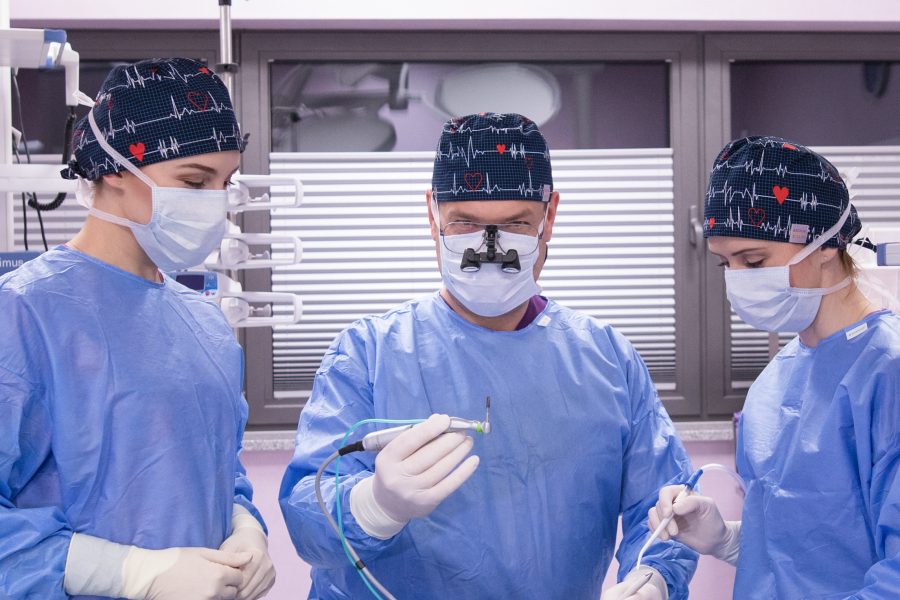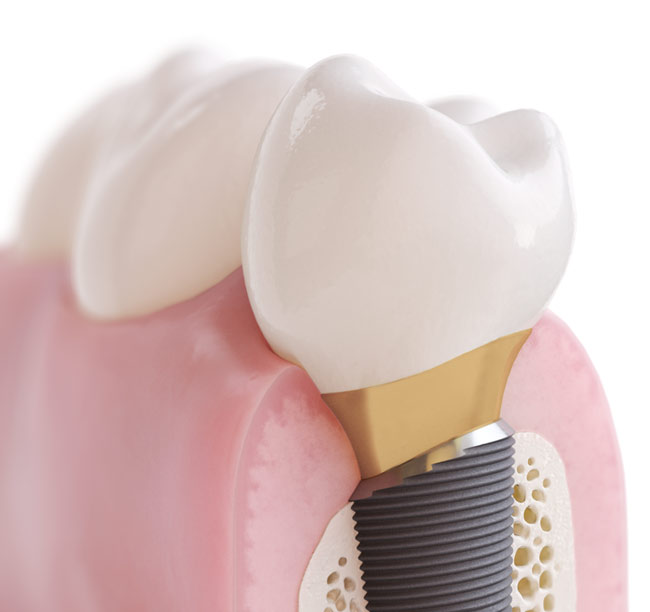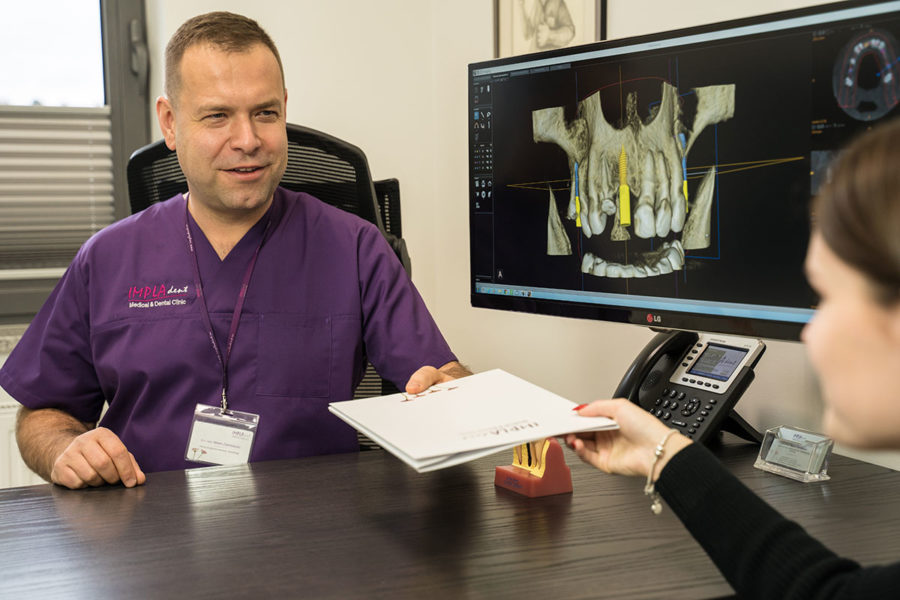Services
Implantology
World class level of implantology

- Over 20 years of experience in implantology.
- 10.000 documented implants
- Success rate of treatments – over 99%
- Doctor of Medical Sciences Adam Ziemlewski is an international lecturer and acclaimed authority in the field of implantology
- Countless awards for the contribution to developing implantology worldwide
- Latest technologies available for our Patients in our Clinic
- Teeth and gum regeneration treatment
- Lifetime warranty on implants and connector
- Zygomatic implants and “teeth in one day” procedure
- Treatments with the use of general and local anesthesia
- Our own CAD-CAM prosthetic studio

Implantology is the most advanced area of stomatology. It requires knowledge, experience and proper equipment. The Impladent Clinic MDC under the leadership of Doctor of Medical Sciences, Adam Ziemlewski is one of the best centers in Poland. 20 years of clinical experience, over 10,000 documented implantological treatments and the success rate of our treatments exceeding 99% are the reasons to start your treatment in our Clinic. We have the most advanced medical and diagnostics equipment. CT scans in both departments, computer programs for surgical simulations. Fully equipped operational and surgical block with the option to perform a surgery with general or partial anesthesia while keeping the highest standards of safety.

Implants are attached to the bone which helps to firmly mount new teeth. The connection strength between the implant and the bone is very high but the integration depends on the type of the surface and the quality of the implant itself. In the Impladent Clinic we use only the premium quality of implants because we aim to eliminate complications and the long-time medical success is the priority when it comes to our Patients.
Implantological treatment grants effective single tooth rebuilding, extensive teeth loss and even anodontia. The assets of using prosthetic work based on implants are aesthetics, stability while biting, preserving taste and preventing the bone from dying out. Proper mastication and what follows food ingestion has enormous impact on your health. While biting, implants like our own teeth, carry the bite force onto the bone tissue which increases the blood supply and prevents unwanted atrophy and slows down face ageing. Filling out teeth loss with the help of implants restores normal, physiological function and a youthful look. But please remember that implants are only a good substitute for your own teeth. Proactive treatment and careful nursing are necessary and will ensure the longevity of your new smile.

The implantological treatment consists of a couple of stages. Firstly, while cooperating with our Patient we create a plan and indications for the treatment. We are always creating a 3D tomography and virtually plan the positioning of implants and the type of prosthetic work. In some cases, or on our Patients demand we create a precise stencil to correctly position the implants (Simplant digital navigation). During this stage we evaluate the quality of the bone tissue and gums, because only a properly mounted implant can function effectively for a life time. Other cases require to plan a reconstruction surgery – tissue transplant or it’s rebuilding with the use of biomaterials.
In the Impladent Clinic we perform a whole spectrum of reconstruction treatments in partial or general anesthesia. Such as transplants of autogenous and allogenic bones, soft tissues and lifting the bottom of maxillary sinus.
However, we try to implement the least invasive procedures for the sake of our Patients healing process so that they can smile without any kind of embarrassment.
We invite you for a consultation where in detail we will show the implantological treatment.

- Filling the lack of one teeth.
- Filling the lack of just a couple of teeth.
- Prosthetic treatment of anodontia.
Filling the lack of one teeth.
One of the recommendations to use implants is single tooth reconstruction. Only they will give the natural feeling of a fully rebuilt tooth. Thanks to implants we will avoid the unnecessary polishing of teeth that are neighboring the gap. Additionally, wearing tooth prosthesis will not be required.
Exemplary treatment process.
Step 1: Specialistic consultation with a RTG examination (dental panoramic radiograph or 3D tomography)
Step 2: Dental implant is being mounted. Healing process depends on the volume, bone condition and medical case itself. Depending on the patient’s health condition the finishing treatment of Step 2 could be one of the following:
- Temporary connector and tooth crown are put on immediately.
- Dental implant is covered with soft tissue and during the healing process, crown of the tooth is attached to the enamel or to a temporal, partially detachable prosthesis.
- Permanent connector and the final crown are put on immediately.
Step 3: Depending on the patient’s clinical condition, the next step could be as follows:
Temporal connector is replaced with a permanent connector. Dental mold is being taken and a temporal crown of a tooth is mounted. After that during the second procedure the dental implant is uncovered and connector is put on. Temporal crown is mounted once again.
Step 4: Brand new crown, meticulously crafted, perfectly imitating a real tooth is mounted permanently to the connector.
Alternative treatment methods.
- Detachable prosthesis of a single tooth mounted on a buckle.
- Bridge attached to the enamel.
- Bridge glued to polished teeth
Samples of implants performed in our clinic.
- 1. lack of left central incisor tooth
- 2. condition after mounting an implant with ceramic connector
- 3. full ceramic crowns and micro-felts
- 4. condition after cementing
- Filling the lack of one teeth.
- Filling the lack of just a couple of teeth.
- Prosthetic treatment of anodontia.
Filling the lack of just a couple of teeth.
When it comes to lack of just a couple of teeth, there is a possibility of rebuilding with single implants and crowns as well as creating bridges on implants. It means that the lack of three teeth can be filled with porcelain bridge mounted on two implants.
Exemplary treatment process.
Step 1: Specialistic consultation with RTG examination (dental panoramic radiograph or 3D tomography).
Step 2: Dental implants are mounted. The healing process depends on the volume and the condition of the bone itself and as well as the clinical aspect.
Depending on Patient’s condition the finishing treatment of Step 2 could be as follows:
- Temporal or permanent connectors and temporal bridge are put on during the healing process. Dental implants are covered with soft tissue. At the request ofour Patient, while healing we put on a temporal, detachable bridge.
- Permanent connectors and the final bridge are mounted immediately.
Step 3: Depending on the Patient’s health condition, the next step could be as follows:
Temporal connector is replaced with a permanent one. Dental mold is being taken and a temporal crown is mounted. During the second surgery the dental implant is uncovered and the connector is mounted. Temporal crown of the tooth is mounted. After the healing process the dental mold is taken for the final crown. The temporal crown is mounted.
Step 4: The final touch is the ceramic filling which perfectly imitates lost teeth.
Samples of implants performed in our clinic.
- 1. Visible teeth implants
- 2. Bridge on implants on a laboratory model.
- 3. Standard screwed-on titanium connectors.
- 4. Cemented bridge inside the oral cavity.
- Filling the lack of one teeth.
- Filling the lack of just a couple of teeth.
- Prosthetic treatment of anodontia.
Prosthetic treatment of anodontia.
In the case of anodontia treatment there is a possibility of a permanent rebuilding with the use of screwed-on prosthesis. The most advanced solution is the ceramic reconstruction of all teeth on a milled framework made out of zirconium dioxide. In this particular case there are requirements in the form of 6 to 8 implants in the jaw and 6 implants in the mandible in order to achieve stable and durable base for mounting the prosthetic structure.
Exemplary treatment process.
Step 1: Specialistic consultation with 3D tomographic examination. Dental mold for models and surgical stencils (to perfectly implement implants during the surgery)
Step 2: Dental implants are mounted. The healing process depends on the volume and the conditions of the bone and the clinical aspect. Depending on the Patient’s health, the finishing treatment of Step 2 could be as follows:
- Temporal or permanent connectors and the temporal full dental arcade bridge are mounted during the healing process.
- Dental implants are covered with soft tissue and the detachable full dental arcade bridge are mounted during the healing process.
- In some instances, it is possible to put on immediately the permanent connectors and the final, full dental arcade.
Step 3: Depending on the Patient’s clinical condition the next step could be one of the following:
Temporal connectors are replaced with the permanent ones. Dental mold is taken and the temporal bridge is put on.
During the second surgery dental implants are uncovered and the connectors are mounted. Temporal, detachable prosthesis is put on. After the healing process dental mold is taken of the final reconstruction. The detachable temporal prosthesis is mounted once again.
Step 4: Ceramic reconstruction of the dental arcade is fixed permanently onto the implants.
Samples of implants performed in our clinic.
It is possible to use implants when it comes to anodontia as an element stabilizing the Patient’s prosthesis. What is needed are 2 to 4 implants in a single jaw bone thus giving us a fully stable prosthesis. Thanks to implants the chewing ability is restored. The pressure on implants stimulates the bone which prevents it from dying out and improves the regenerative process.
Food can be chewed properly which protects us from serious general systemic complications connected to improper nutrition. The process of introducing implants is a more subtle and delicate one compared to teeth removal. The feeling of discomfort and fear is completely eliminated. In a more complicated instances where the Patient does not have the proper anatomical requirements to put on an implant, guided bone regeneration and soft tissue regeneration becomes a necessity.
Personnel
Below we present our Medical Specialists, who will take care of you in our Clinic.